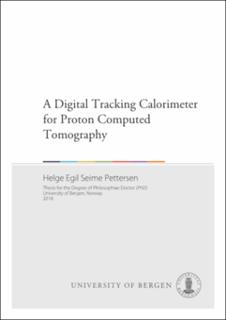| dc.description.abstract | Cancer is a destructive disease, in which tumor cells grow out-of-control, halting organ function. Its treatment is threefold: Radical surgery, chemotherapy and radiation therapy. Their relative usage is determined by cancer type, stage, organs at risk adjacent to the tumor and progression. There has been a significant increase in the number of cancer patients treated with radiation therapy using particle therapy in the recent decades worldwide. Short term and long term treatment-induced side effects are reduced when applying particle therapy due to the superior dose conformality compared to conventional radiation therapy using photons. The particle species commonly applied during particle therapy is the proton. Proton therapy as of today is performed with the delivery of pre-calculated dose plans for each patient: the applied dose plans are made based on x-ray computed tomography (CT) images. The CT images are reconstructed based upon photon interaction with matter, thus a conversion is required for calculating the Relative Stopping Power for how the protons traverse and deposit dose in the patient’s body during proton therapy. This conversion procedure introduces range uncertainties typically in the order of 2%–3%, corresponding to 4–6 mm at a treatment depth 20 cm into the patient. A proton CT system would yield a means of direct calculation of the RSP map in the patient. During a proton CT scan, a high-energy proton beam is directed at the patient and the proton beam must have sufficient energy to completely pass through the patient being imaged. The protons’ residual energies are measured after they have traversed through the patient and into a detector behind to the patient. The information about the residual energy from each proton can then be used, together with the proton’s estimated path through the patient, as a basis for reconstructing a volumetric RSP. In this thesis, the feasibility of using a purely pixel-based detector, a so-called Digital Tracking Calorimeter (DTC), for proton CT purposes is investigated and its performance quantified through experiments and Monte Carlo simulations. The DTC is designed for tracking and measuring the range and energy of individual protons in a proton beam. The DTC consists of multiple layers of semiconductor pixel sensors with a digital readout, interleaved with a passive absorber material for energy degradation. The sensor chips are considered near optimal for use in the tracking, due to their data processing capacity at the required readout speed, the high granularity of such a detector system and also due to their short radiation thickness. The requirement to this part of the detector is that it must be able to allow for reconstruction of a large amount of proton tracks in each data readout cycle, enabling high proton rate capabilities. The DTC was originally designed for the reconstruction of high-energy electromagnetic showers for the Forward Calorimeter project in the ALICE experiment at CERN. The presented prototype forms the basis for a proton CT system using a single pixelbased technology for both tracking and calorimetry. This advantage simplifies the setup and reduces the cost of a proton CT system assembly, and it is a unique feature of the Digital Tracking Calorimeter concept. Measurement data from the AGORFIRM beamline at KVI-CART in Groningen in the Netherlands and Monte Carlo simulation results are used in order to develop a proton tracking algorithm for the estimation of the residual ranges of a high number of concurrent proton tracks. The range of the individual protons can with the first prototype be estimated with a range resolution of 6–25 mm Water Equivalent Thickness. This relatively low achieved range resolution is expected due to the original design goal of the prototype. The readout system for this prototype is able to handle a proton intensity of 1 million protons/s by using 500 concurrent proton tracks in each readout frame, which is comparable to present similar prototypes. A next prototype of the proton CT setup using the DTC is at present in the construction stage. A DTC further optimized for use in a proton CT system will utilize next-generation Monolithic Active Pixel Sensors with larger sensor areas and a hundredfold increase in readout speeds. The developed proton CT analysis framework is applied on a variety of possible DTC geometries for the next prototype. The potential design choices are evaluated on basis of the reached range accuracy and range uncertainty as well as of the track reconstruction efficiency. A design recommendation is reached where the proposed DTC will have 3.5 mm thick aluminum absorber slabs between each sensor layer. Some of the tools applied in this thesis for the purpose of proton range calculation have been validated through comparison studies: First, different MC programs are compared to each other and to available experimental data. Secondly, the accuracy and usability of several available proton range calculation models are evaluated through their capability of reproducing tabulated energy-range proton values. An accurate model is found and applied throughout this thesis for proton range reconstruction purposes. | en_US |

